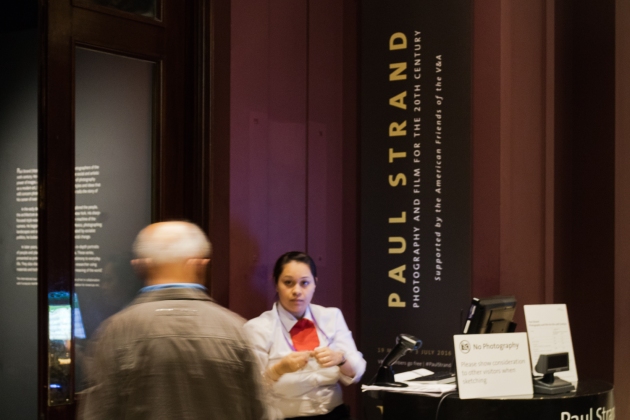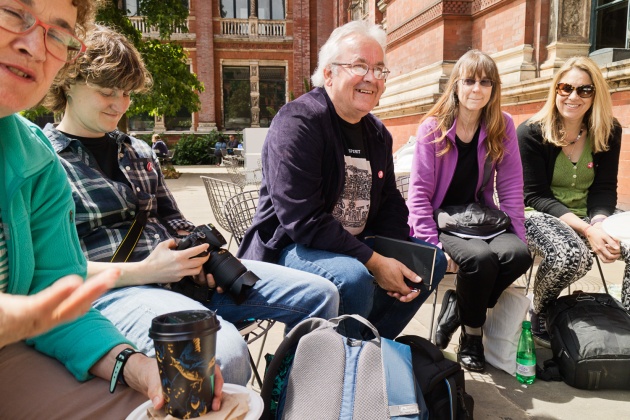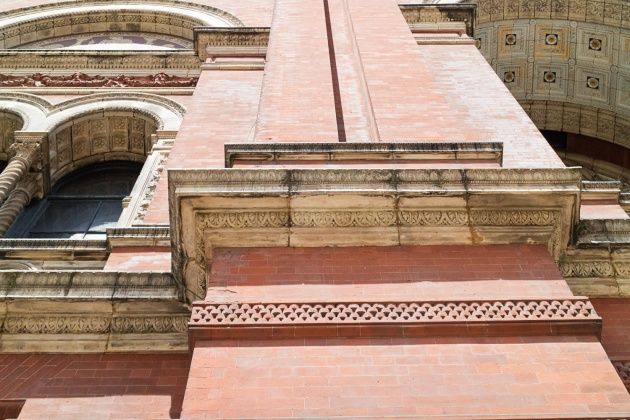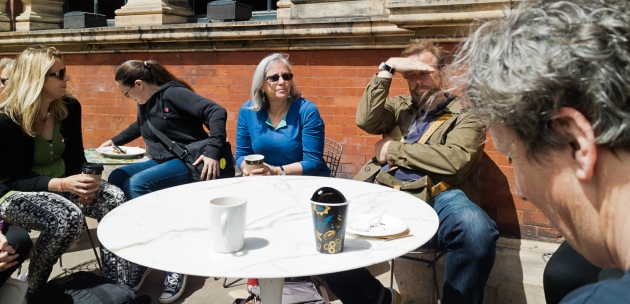 A second chance to see the Paul Strand exhibition, this time with the Open College of the Arts, which means there might be a chance to discuss it or at least get some feedback from a tutor, in this case, Robert Broomfield.
A second chance to see the Paul Strand exhibition, this time with the Open College of the Arts, which means there might be a chance to discuss it or at least get some feedback from a tutor, in this case, Robert Broomfield.
I have been reading some of the essays about Strand that were published around the time of the centenary of his birth. More insights into this enigmatic photographer.
The college hand out suggests we read O’Hagan’s piece about revisiting Lazzara, the Italian village that Strand photographed; I did this prior to my first visit and it is an interesting revisit to the Italian town Strand photographed. The college also suggests we read a more in depth view on the Swiss Fotomuseum website. This article discusses the political framework around Strand’s work and the situation of that time; a reference is made to The Family of Man exhibition. Were Strand’s photographs shown in this somewhat romantic view of a post-war world?
Strand himself regarded as a “romantic communist” by some while his focus on rural communities reveal a sensitivity towards a spontaneous kind of communism that exists in a natural state. This is revealed in his Photobooks such as Un Paese about an Italian town in the Po valley.
We meet Robert Broomfield at the entrance to the museum who advises us to a quick tour of the exhibition before returning to work though more slowly looking at images that have one’s eye!

A Modern Vision
The first I see is Blind! Taken with Strand’s angled camera, this surreptitious shot reveals that the woman questioned might actually have one good eye! It has been referenced as an image about photographic seeing.
Yawning Woman is another photograph that draws my attention! One student later remarks that this reminds her of some of Bruce Gilden’s candids although his of course are done with the full knowledge of the sitter.
White fence is a famous shot, much written about.
Jug and Fruit seems to be a combination of both traditional still life painting and Cubism.
Railroad Sidings is a graphic composition that pulls the eye.
Manhatta is a Modernist film about the Manhattan district of New York. In retrospect, it seems to be an idealistic view of city life where smoke can curl romantically rather than dismally, encumbered as we are with the knowledge we have today about pollution. The poetry in this film is uplifting as are the high rise buildings; no criticism here of urban sprawl rather delight in its mechanical complexity. It is not easy to see where Strand might be coming from! Possibly irony? Robert does not think so but this is one of those questions that might be explod further; was Strand using irony or was he a genuine Modernist. I assume the latter but a little piece of curating commentary later on suggests otherwise.
Looking at Nature
Toadstool and Grasses
Another famous image that looks better as a print, in this case, a platinum print.
Fern, New England
Tone and detail are exquisite!
Intimate Portraits
Alfred Steiglitz, 1920; a well known figure who exerted considerable influence on Strand but whom he later lost contact with. Robert sees this as a loss on Strand’s part and that his work never retained the quality of these years.
Truck man’s House, March and August 1922
Strand describes the change between these two images in a letter to Steiglitz; was he being ironical in his description of the change as “progress”? The original letter is not visible so this is a Point that needs further examination.
Two of his cameras are exhibited in this room and act as a reminder to the heavy weight equipment he used; little chance for hurried images on the street that Caryier-Bresson was later able to accomplish with the much smaller Leica that could be handheld.
America, Canada and Mexico
Red River (photograph of a wooden door)
Church, Cuapiaxtla, Mexico
Black sky, white building!
Men of Santa Anna
Cristo with Thorns
A statue? A man wearing a mask? This leaning figure is mysterious although the crown of thorns is a well known Christian symbol.
The film Native Land is about the harsh, murderous treatment of workers in the cotton picking South. It cuts across the racial divide showing a white man trying to help a blackman but both are eventually shot down though this is not the end of the film as the action changes to the pastoral delights of a country town which remains unaware of what is happening elsewhere.
Portraits of Places
Meeting House
Simple arrangement yet quite complex composition with a window that allows one to see through to a landscape via another window on the opposite side of the room. From outside to inside to out!
Mill Dam, Vermont
A composition of geometric proportions as the houses fit in with each other.
Door Latch
Basic formal arrangement of wooden structures.
Jack-in-the-Pulpit
A nice nature image with formal composition.
I meet the OCA Tutor at this point and we talk firstly about the printing with which we are both impressed even though it does not reach the heights of Ansel Adams who was working at this time and developing his Zone system. Strand’s prints have a subdued quality and contain the necessary detail. Tutor, Rob Broomfield, finds Strands’ later work to lack the early concern with form that Strand had inherited from his mentor in New York, Alfred Steiglitz. Does Strand’s later work reflect a certain lack of meaning as it becomes more documentary than art orientated? Another question that might be further considered.
France
Young Boy
A much used image and perhaps something of a gay icon nowadays. The print here seems rather dark.
Drogerie, Pyrenees
An intriguing combination of forms that also feature a small dog.
Hebrides
Tir a’Mhurain, 1954
A pleasant landscape which is enhanced not just by the solitary house in the centre but also by a group of horses. As one student comments, “A mixture of isolation and living presence!”
Mrs. Archie Mac Donald
This photograph is enhanced by audio of her singing. It was her singing, which reminds me slightly of Tibetan singing, that drew Strand to South Uist since it was broadcast on the BBC.
Luzzara
The Family
Classic image, much reproduced. Standing close to an original allows one to inspect the detail but this image is really about the picture of a family gathering at the front of their house.
This part of the exhibition interests me because it relates to a photographic project I am working on at present. Here is an inventory of the photographs used for this exhibition; house and other houses,meeting place, 6 portraits, chopping block, the family at the entrance to their house, 3 portraits one showing labourer with giant cheese, cultivated field with house in background, milk pails, tailor’s apprentice, hallway of house, harness for horse, elderly couple, hat factory, worker’s bicycles standing against trees, a landlord seated; 22 images of which 10 are in 2 groups (one of 6 portraits, one of four mostly poraiture).
Ghana
Mary Hammond, a small semi-naked child, regarding the photographer sensitively!
Anna Attinga Frafra
Books are piled on her head; shows that Strand did pose his subjects!
Roadside Market, Brong
Finely printed with delicate detail emerging from the shadows
Romania
Couple from Romania; romantic image perhaps of couple though their surroundings look bleak. Nice range of tones from dark foreground of individuals to misty farm and land behind.
Was to have been a book; trouble initially with communist authorities then an author could not be found!
At home in Orgeval (The Garden)
Strand returning to his Modernist roots perhaps? Some carefully composed images! Prints are clearer than his early work from New England but Robert, OCA tutor, thinks that these images do not retain the attention to form that Strand revealed in his earlier work.
The Happy Family shows a group of delicate flowers, their petals intact; made in 1958, the print is from 1976. The white flowers are surrounded by darker undergrowth and stones.
The published book of the garden images is not one Strand made; it was done pothsumously. However, Strand did make portfolios of his garden works which were made available to collectors and contained prints made under his direction. He wrote the following in an introduction …”The critical moment for the photographer is the moment of seeing … ” Strand describes this as a creative act which is initially involved with perception and finally by the mechanics of making the photograph. While emphasising the contemplative moment that the photograph involves, he ends by talking about science and art and quotes a scientist he knew called Harlow Shapley, an astronomer, who wrote “Continually our eyes are opened wider, the depth of of our vision is increased.“This is just what Strand was trying to demonstrate through his photography.
Another camera placed near the exit is a reminder of the kind of basic equipment he used. No automated features here, everything needed to be considered. The cameras were also much bigger and hence an object that the sitter was aware of unless Strand was using his angled camera to make portraits of people unawares.
Imagine buying a 20 year old camera and then using it for 50 years!!?

Afterwards, we chat in the V&A courtyard, as a group.
Paul Strand adopting a position of unequal power in his use of a side-view camera!? Yes, but by doing so he was able to capture people not unconsciously posing for the camera and thereby providing something more authentic.
A romantic in his photographic view of communism? Possibly an idealist?
Tutor sees exploration of form as essential to Strand’s oeuvre so although he saw this exhibition as challenging to any preconceived notions, they seem to have emerged intact!?
Strand spent a long time in a place to get to know it as do photographers these days.
Images preconceived not instantaneous as in street photography; Strand used a large camera!

Dead pan approach, lack of emotion!. Attention to detail, fair representation!
Limitations of media in his time effect his output pictorially.
Why can’t we be Modernists now?! Early Strand demonstrates this attention to form but even later garden photos, it is not so strong or pure!
Strand depicting higher echelons of society in his Ghana photographs.
Group expedition to Luxembourg to see Family of Man exhibition?
Robertbloomfield@oca.ac.uk would like link to my blog!!

click HERE for a link to my previous visit to this exhibition and the day symposium about Strand.
Pingback: Paul Strand at the V&A | Amano photographic studies